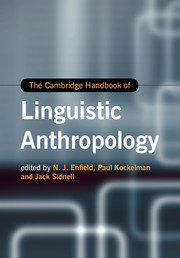Crossref Citations
This Book has been
cited by the following publications. This list is generated based on data provided by Crossref.
Cowley, Stephen J.
and
Vork Steffensen, Sune
2015.
Coordination in language.
Interaction Studies. Social Behaviour and Communication in Biological and Artificial Systems,
Vol. 16,
Issue. 3,
p.
474.
Enfield, N.J.
2015.
Linguistic Relativity from Reference to Agency.
Annual Review of Anthropology,
Vol. 44,
Issue. 1,
p.
207.
2015.
Publications Received.
Language in Society,
Vol. 44,
Issue. 2,
p.
293.
2016.
Language Maintenance and Shift.
p.
1.
Weigand, Edda
2016.
How to verify a theory of dialogue.
Language and Dialogue,
Vol. 6,
Issue. 3,
p.
349.
Pelkey, Jamin
2016.
Symbiotic modeling: Linguistic anthropology and the promise of chiasmus.
Reviews in Anthropology,
Vol. 45,
Issue. 1,
p.
22.
Black, Steven P.
and
Falconi, Elizabeth A.
2017.
The Handbook of Linguistics.
p.
479.
Swiggers, Pierre
2018.
Editée par/Edited by Anne Aarssen, Ekaterina Bobyleva, René Genis, Sijmen Tol and Eline van der Veken, with the assistance of Femmy Admiraal, Nadia van den Berg and Nozomi Cho.Linguistic Bibliography for the Year 2015 and supplement for previous years.
Historiographia Linguistica,
Vol. 45,
Issue. 3,
p.
403.
McManus, Matthew
2019.
Linguistic Meaning, Rigid Designators, and Legal Philosophy.
Philosophies,
Vol. 4,
Issue. 2,
p.
15.
De Fina, Anna
and
Georgakopoulou, Alexandra
2020.
The Cambridge Handbook of Discourse Studies.
ZUCKERMAN, CHARLES H. P.
2020.
“Don't gamble for money with friends”.
American Ethnologist,
Vol. 47,
Issue. 4,
p.
432.
Foley, William A.
2020.
The Encyclopedia of Applied Linguistics.
p.
1.
Khor, Su Yin
2020.
The International Encyclopedia of Linguistic Anthropology.
p.
1.
Stanlaw, James
2020.
The International Encyclopedia of Linguistic Anthropology.
p.
1.
Gainotti, Guido
2021.
Is There a Causal Link between the Left Lateralization of Language and Other Brain Asymmetries? A Review of Data Gathered in Patients with Focal Brain Lesions.
Brain Sciences,
Vol. 11,
Issue. 12,
p.
1644.
Nation, I.S.P.
and
Coxhead, Averil
2021.
Measuring Native-Speaker Vocabulary Size.
Ryding, Karin
and
Wilmsen, David
2021.
The Cambridge Handbook of Arabic Linguistics.
Ayres-Bennett, Wendy
and
Bellamy, John
2021.
The Cambridge Handbook of Language Standardization.
Voelkel, Svenja
and
Kretzschmar, Franziska
2021.
Introducing Linguistic Research.
Ahmadian, Mohammad Javad
and
Long, Michael H.
2021.
The Cambridge Handbook of Task-Based Language Teaching.



